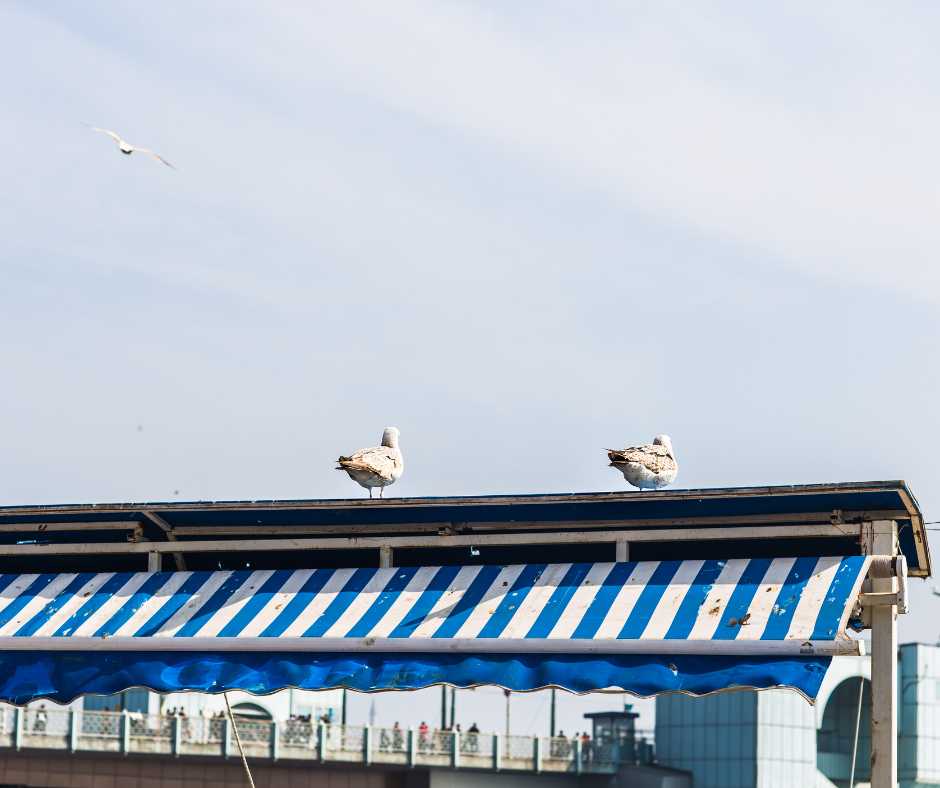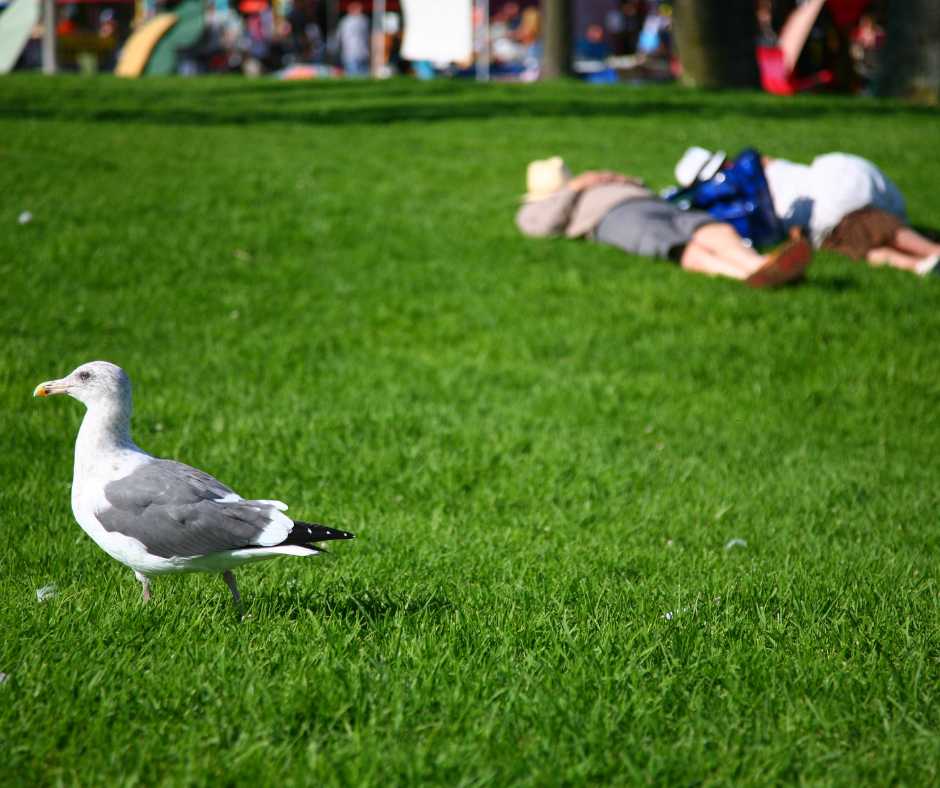Imagine walking through the busy streets of your city, skyscrapers towering above, when suddenly, you hear the familiar squawk of a seagull. It’s a sound you’d expect at the beach, not amid the hustle and bustle of urban life. Yet, there is a seagull perched confidently on a building ledge.
This sight leads us to an intriguing question: “Where Do Seagulls Nest?” Contrary to what many might think, seagulls have a surprising range of nesting spots. From the classic rocky cliffs by the sea to the unexpected nooks of our cityscapes, these adaptable birds find various places to call home.
Studies like the one conducted by Rock (2005) reveal that such urban sightings are becoming increasingly common as seagulls adapt to city life, showcasing their remarkable behavioral flexibility.
In this exploration, we’ll uncover the diverse habitats of seagull nests, shedding light on their adaptable and often surprising nesting habits.
Where Do They Nest?
Seagulls are pretty incredible birds. Most of us think of them near the ocean, swooping over the waves and beaches. They usually make their nests on cliffs and sandy shores, where they can be safe and find lots of food.
But guess what? Seagulls are starting to make their homes in cities, too! More and more, you might see them nesting on top of buildings, along the edges of rooftops, or even in places with lots of factories and noise.
This big move from the beach to the city is a big deal. It shows that seagulls are good at adapting. They’re not just beach birds; they’re becoming city birds, too! Seagulls are getting used to living among the tall buildings and busy city streets.
They’re finding new ways to live and are pretty clever at using the spaces we’ve made. So, the next time you see a seagull in your city, remember that it might not just be stopping by. That city might be its home!

Traditional Nesting Habits of Seagulls
Seagulls are iconic seaside birds, often seen gliding above beaches and cliffs. These natural habitats are more than just scenic spots; they are essential for the seagulls’ survival. Cliffs offer safety from predators and a broad view to spot food and danger. This high vantage point is a strategic choice for these birds, not just a place for a good view.
On the other hand, beaches and islands provide open spaces vital for seagulls’ activities like landing and taking off. The calmness of uninhabited islands is particularly beneficial for raising their young away from disturbances.
These areas are not just safe havens but also rich in food sources like fish and crustaceans, making them perfect for seagulls, especially during the breeding season.
This adaptability, particularly in their feeding habits, has been highlighted in research by Soldatini et al. (2008), who found that seagulls have increasingly turned to landfills in urban areas for food.
Understanding these natural habitats of seagulls helps us appreciate their importance beyond just being part of the beach scenery. They are crucial ecosystems supporting the life cycle of these fascinating birds.
You can also read: Purple Finch Nesting
Why Are Seagulls Making Their Homes in Cities?
Lately, you might have noticed more seagulls in the city, a place quite different from their usual spots by the sea. It’s interesting to see these birds choosing city life. Why do you think that is? Well, cities offer lots of food and are safer for them.
In the city, seagulls find lots of food with little effort. They can snack on leftovers from street food, dig through our trash bins, and even find treats at dumpsites. For them, it’s like finding treasure every day, especially when finding food in nature is challenging. Plus, cities are safer for them.
There aren’t as many animals around that might bother them or their babies, which makes cities a good place for their nests.
Seagulls in cities also pick the best spots for their nests, like rooftops, chimneys, or edges of tall buildings. These places are high up, like the cliffs they’re used to, giving them a great view and keeping them safe.
Seeing seagulls living in our cities is something special. It shows us how wildlife, like seagulls, can fit into our city life. It’s a good reminder that our cities are home to more than just people – they’re places where animals like seagulls live, too, and our choices can make a big difference to them.

How Does Seagull Nesting Affect City Life and Environment?
Seagulls living in cities isn’t just something funny; it changes things for birds and people. Having nature right in our busy city life is interesting, but it’s not always easy.
For seagulls, being in the city is a mix of good and challenging times. They find lots of food, which is excellent, but they also have to deal with things like cars zooming around and dirty air. These problems can make it hard for them to stay healthy and safe.
Having seagulls around can be calm for people because it’s like having a piece of nature in the city. But sometimes, they are too much. They’re loud, and their nesting can make a mess, even damaging buildings sometimes. That’s why we must think about living together without too much trouble.
A guy named Belant wrote in 1997 about how cities need to plan their spaces to make life suitable for both people and seagulls. It’s all about finding a balance.
So, cities have a big job to do. They must figure out ways to ensure people and seagulls can live peacefully together. This means everyone needs to understand and help, both people and seagulls.
Having seagulls in cities shows us how connected we are to nature. It’s a reminder that we should be careful about how we affect animals like seagulls. As we go forward, we need to think about how to share our city spaces with them in a way that’s good for everyone.
Sharing Our City Spaces with Seagulls: What Can We Do?
Living in a city with seagulls as our neighbors comes with its own set of challenges. Laws protect these birds, so we can’t disturb their nests or harm them. But there are still things we can do to live together more efficiently.
For people and businesses in the city, a big help is dealing with trash the right way. Seagulls are drawn to open garbage and leftover food. We’ll see fewer seagulls around if we keep our trash bins closed and don’t leave food out. It’s a simple step, but it helps.
If you find seagulls nesting in places like your roof and it’s causing trouble, it’s best to get advice from people who know about wildlife. There are ways to make seagulls nest somewhere else, using things that won’t hurt them. It’s all about respecting the birds while keeping our places safe and clean.
We should also think about how our actions affect these birds. Feeding seagulls might seem friendly, but it can bring more of them to the area and cause problems. If we’re thoughtful in how we act around seagulls, we can make our cities welcoming for us and the birds. It’s about finding a good balance and respecting our shared space.

People Also Asked
What are the typical nesting habits of seagulls?
Seagulls usually nest on cliffs and beaches, but they’re also happy to make their nests on city rooftops or ledges. They like to build their nests in spots where they can easily see around them, using twigs, grass, and even stuff they find in the city. Seagulls lay their eggs around spring and take turns keeping them warm until they hatch.
Can feeding seagulls in urban areas cause problems?
Yes, feeding seagulls in the city can cause some issues. When seagulls get used to being provided by people, they can gather in large numbers, which can be noisy and messy. It can also make them less scared of people, which might lead to them snatching food right from your hands!
What should I do if I find an injured seagull or abandoned chicks?
If you find a hurt seagull or chicks that seem to be alone, the best thing to do is to call a local wildlife rescue or animal control. They are the experts and know how to help these birds safely. It’s essential not to take care of them yourself, as wild birds need special care.
Can seagulls be a health hazard in urban settings?
Seagulls in cities can sometimes be a health concern, mainly because of their droppings. Their poop can carry germs, and if there’s a lot of it in places where people walk or play, it can be a bit risky, especially in crowded areas. That’s why managing where seagulls hang out in cities is essential for keeping everyone healthy.
Wrap Up
We’ve seen that seagulls are pretty amazing at finding new places to live, from beaches and cliffs to city rooftops. Their ability to adapt to different places, including our busy cities, is awe-inspiring.
This teaches us a lot about how nature changes and how we affect it. We have a big part in making sure we can live well together with seagulls in our cities. Simple things like keeping our trash in check and being kind in how we handle any issues with seagulls matter a lot.
Let’s appreciate seagulls in our cities. They show us how nature is robust and adaptable, just like us. We must respect and care for them so our cities can be good homes for people and wildlife.

